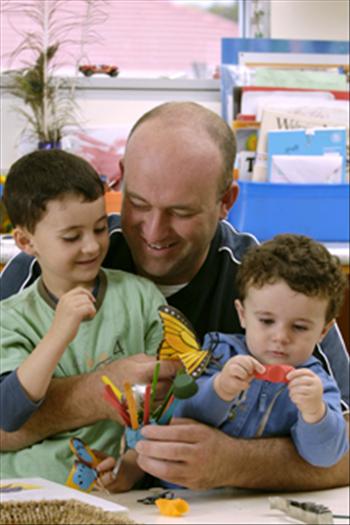Playing with playdough
Duration/age

Playing with playdough is a wonderful opportunity to creatively explore what objects can be made but also to engage in pretend play. By adding patty pans, bowls, biscuit cutters, baking trays, and coloured stones suddenly your child is making cupcakes and biscuits for a birthday party. Take away the cooking utensils and add sticks and feathers and the activity can change to making birds and a bird’s nest.
As you and your child play together with the playdough, count how many things you have made, talk about the process of making the objects and use lots of descriptive language to describe what has been made. You could talk about the thickness of the biscuit, the colour of the Smartie (stones) on top of the cake, or the depth of the bird’s nest.
Materials you will need
- Table
- Playdough
- Rolling pin
- Cooking utensils
Alternative tools
- Sticks
- Stones
- Feathers
- Gumnuts
- Pop-sticks
Skills this activity improves
Why does this matter?
Rolling, squeezing, pushing and pulling the playdough helps develop strong muscles in children’s fingers and hands. As they roll small balls or long thin sausages they are training their fingers to separate and to move apart which will be needed for holding a pen. As they pretend to create meals for the family or objects they have found in the garden they are representing their ideas and knowledge and using language and images to share their ideas with others. When you play with your child they are listening to instructions and directions and learning to follow and respond to the information you are sharing.
What does this lead to?
Through interacting and creating with playdough children are developing hand dominance (left hand vs right hand) and hand control. This is important to enable children to write for extended periods of time and to create small detailed pictures. If a child has not developed good hand control they will tire quickly when writing, use their shoulder to move the hand rather than the wrist and will find it difficult to create small connected letters. Experimenting with playdough also provides children with the opportunity to develop social language and to learn how to take turns in a conversation.
Language to use
- Long, short
- Thick, thin
- Big, little
- Top, bottom
- Next to, between
- First, last
- Red, green, yellow, blue
- 1, 2, 3
- Lots, many, few, more, less, enough
Questions to use
- What are you making today?
- How many cakes have you made?
- How long do the cakes need to cook for?
- Which is the thinnest biscuit?
- How many cakes will you need to make so that each person in the family can have one?
Useful tips
- You can buy playdough or make your own.
- You might also want to look at the Make your own playdough activity. This activity includes a simple playdough recipe.
- Store playdough in an air tight container.
- Food colouring can be used to change the colour of the playdough when you are making it.
- Remember to talk to your child in your home language.
More ideas
- Make the playdough with your child.
- Add a favourite recipe. Can you make playdough chocolate crackles?
- Make a playdough recipe book.
- Set up a resource box for playing with the playdough.
- Make designs on paper for your child to trace on the playdough.
Variation by age
Birth to two year olds
- Place big containers on the table for filling and emptying.
- Place muffin tins on the table for filling with playdough.
- Add sticks and pop sticks for pushing into the playdough.
- Add rollers, plastic spatulas and egg rings for cutting out biscuits.
Three to five year olds
- Make the playdough with your child.
- Add a favourite recipe. Can you make playdough chocolate crackles?
- Make a playdough recipe book.
- Set up a resource box for playing with the playdough.
- Make designs on paper for your child to trace on the playdough.
Questions to use
- Which is bigger?
- How many do you have?
- Who are they for?
- Are they ready to eat yet?
Questions to use
- What do you need to do first?
- What does the recipe say?
- What pattern is this?
- Which is the thinnest?
- Where could we put______?


